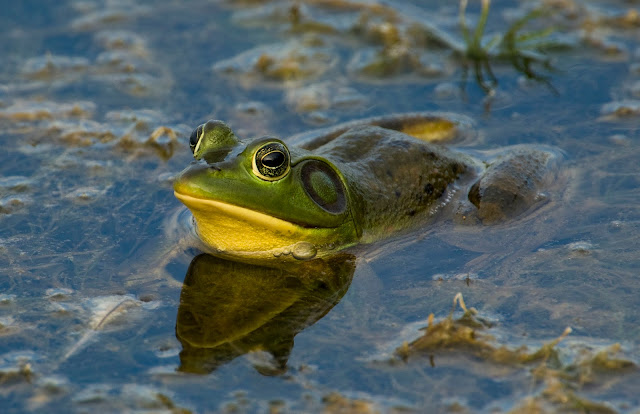Frogs are cold-blooded amphibians. Adaptations insure survival in various habitats: on the ground, in fresh water, in trees, in burrows. Flooded areas provide temporary dwellings.
Moisture is essential because of smooth, permeable skin susceptible to dehydration. Frogs do not drink but absorb water (and oxygen) through skin. Nostrils also inhale oxygen. Insufficient oxygen underwater causes drowning.
Skin is camouflaged in brown, gray, and green. For many frogs, changing color regulates body temperature. Some colors declare toxicity: red, blue, yellow, black. Predators, such as birds and reptiles, are further deterred with distasteful or toxic milky secretions, often containing mucus. Besides moistening the skin, slimy secretions hinder capture.
 |
| Pig Frog - photo Charlie Corbeil |
Southern leopard frog - photo Brett Pigon
Barking treefrog - photo Brett Pigon
Cuban treefrog (invasive) - photo Brett Pigon
Handling frogs is unsafe. Toxins may cause rashes, hallucinations, or death. The golden poison dart frog of the Colombian rainforest harbors enough poison to kill ten men.
Did you know? Bulging eyes furnish outstanding vision. Blinking while swallowing sinks eyeballs, causing a swelling on the roof of the mouth which squeezes food down the throat. Seeing and hearing (ears are circles behind eyes) is possible underwater. A cleft tongue, attached in front, readily captures insects. The upper jaw has teeth to secure prey. Long, muscular hind legs and webbed toes facilitate swimming. Springy tendons promote jumping 20 times one’s length. Some with short back legs tend to walk. Rings formed in bones during hibernation determine age—similar to trees. Molting occurs routinely; own shed skin is usually consumed. Though frogs and toads entertain similarities, neither spreads warts to humans!
Unique adaptations exist. Burrowing frogs have toe extensions (spades) for digging; tree frogs have large adhesive toe pads for climbing; some rainforest frogs have flaps to glide from tree to tree.
During the mating season, a male’s vocal sac (or sacs) inflates like a bubble and amplifies sound; mating songs may travel a mile. Mostly males sing—helpful for sexual identification. When imperiled, silence prevails.
The majority of species practice “prolonged” breeding, frequently involving annual migrations of thousands. Small Florida wetlands are choice breeding shelters. Eggs are generally laid in the water, hatching into fish-like tadpoles (polliwogs).
In Florida, intriguing frogs are the sizable bullfrog sometimes measuring 12 inches outstretched. The hind legs are a delicacy. The second largest is the mostly aquatic pig frog which mimics the guttural grunts of a pig.
Regrettably, frogs are encountering fungal disease and abnormalities involving missing or extra legs. Hopefully, they will endure because they are beneficial, particularly in the development of pharmaceuticals. Moreover, on a spring evening with heavy rain anticipated, the mating croaks of an army (group) of frogs are soothing.
Lindsey Mattessich placed 1st for grades 9-12, at this year’s The Charlie Corbeil Conservation Awards Youth Arts Contest. Lindsey claims, “The collage was inspired by my interest in Floridian birds and all Floridian wildlife….Conservation is important to me because I feel it is our responsibility to protect the planet we are living on. We need to give just as much as we take.”
 |
| collage by Lindsey Mattessich |